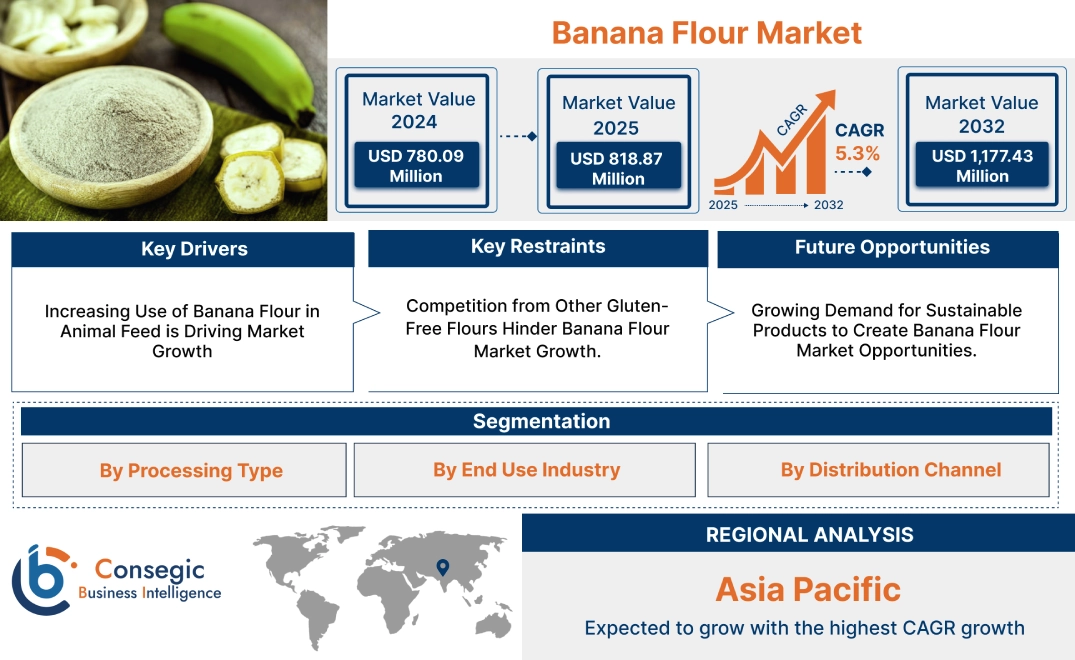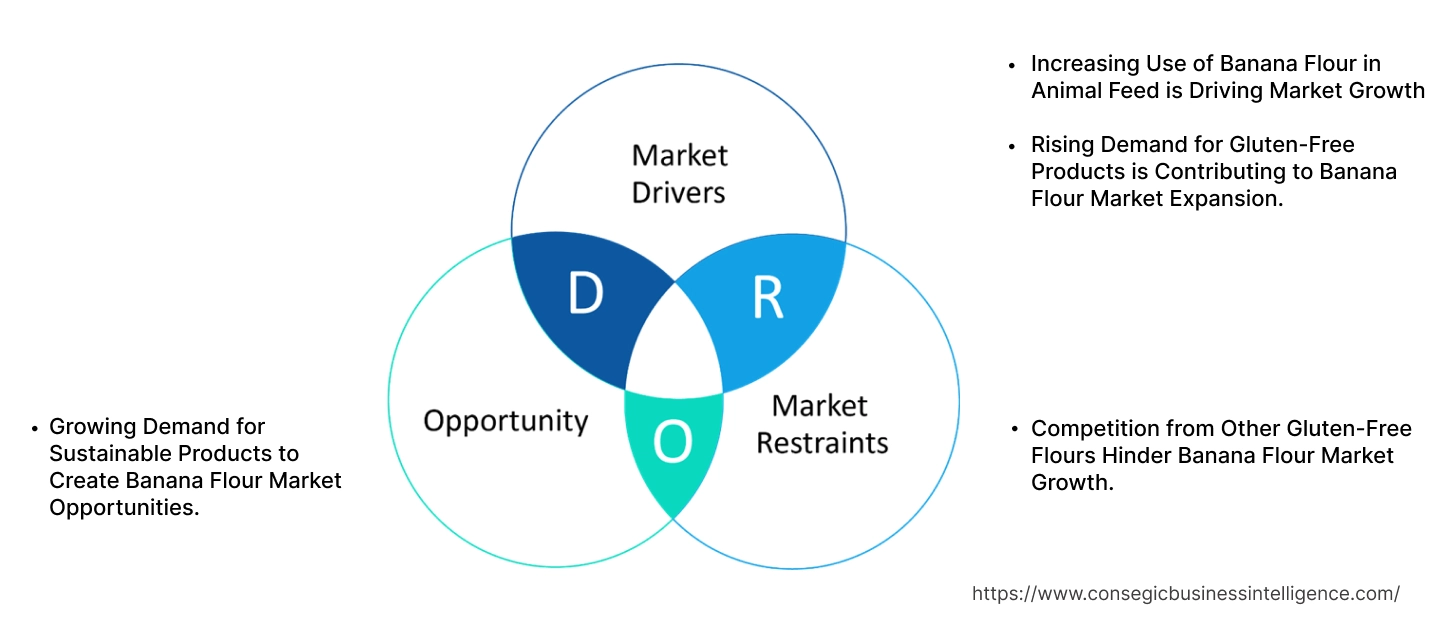- Summary
- Table Of Content
- Methodology
Banana Flour Market Size:
The Banana Flour Market size is growing with a CAGR of 5.3% during the forecast period (2025-2032), and the market is projected to be valued at USD 1,177.43 Million by 2032 from USD 780.09 Million in 2024. Additionally, the market value for 2025 is attributed to USD 818.87 Million.
Banana Flour Market Scope & Overview:
Banana flour is a powder produced from green, unripe bananas. Production involves several different processes through which banana flour is obtained. A few of the key processes are freeze dried, spray/drum dried, sun dried, and others. It has applications, from baking and thickening sauces to enhancing smoothies across several end use industries such as food and beverages industry, retail/household, and others. A key distinction exists between flour made from banana and banana powder is that banana powder is processed from ripe bananas and showcase a sweeter taste due to its higher sugar content. The increasing prevalence of gluten intolerance is one of the key factors contributing to market trends. Its properties and diverse applications position it as a valuable ingredient.
Key Drivers:
Increasing Use of Banana Flour in Animal Feed is Driving Market Growth
Banana flour offers a range of nutritional advantages for livestock. These include advantages such as high levels of resistant starch, beneficial fiber content amongst others. These are contributing to improved animal health and digestion. This ingredient is incorporated into feed for various animals, from poultry and swine to ruminants and even aquaculture.
- For instance, in 2024, according to a study conducted by BIO Web of Conferences stated that the incorporation of banana flour as a feed additive in the aquaculture increases the survival rate of Rohu fish by 90%.
Furthermore, the use of additional or damaged bananas for flour production offers a sustainable solution by reducing food waste. Thus, due to the above-mentioned factors, the adoption rate of flour made from flour in animal feed is increasing.
Rising Demand for Gluten-Free Products is Contributing to Banana Flour Market Expansion.
The growing awareness of Celiac disease which is a condition caused by immune reaction because of consuming gluten and gluten sensitivity increases globally, consumers are actively seeking alternatives to traditional wheat-based flours. Banana flour, being naturally gluten-free, presents itself as a suitable option. Its usage in various food applications makes it an attractive ingredient for both household as well as food and beverage end use industry.
- For instance, according to ScienceDirect, the demand for global demand for products that are gluten-free has increased by roughly 16% during 2018 and 2022.
Thus, as per the market analysis, the rising popularity of gluten-free diets contributes to the increasing requirement for flour made from banana, in turn driving market growth.
Key Restraints:
Competition from Other Gluten-Free Flours Hinder Banana Flour Market Growth.
Consumers have several options available for banana flour. A few of the key options are nut, grain, and root flour. These are due to their wider availability. A few specific alternative flours are also preferred for specific culinary applications, in turn limiting market’s development. Additionally, the awareness related to flour produced from banana is on the lower side as lot of individuals are not aware of its benefit. Moreover, flour made from banana contributes to the higher price of the flour made from banana as compared to its alternatives leading to the consumer preference towards these substitutes. Hence, the aforementioned factors are restraining banana flour market growth.
Future Opportunities :
Growing Demand for Sustainable Products to Create Banana Flour Market Opportunities.
The production of banana flour utilizes additional or imperfect bananas. These contribute to reduced food waste, in turn aligning with sustainability goals. Furthermore, eco-friendly production practices are contributing towards environmental sustainability goals. These factors allow banana flour key players to differentiate themselves. They differentiate themselves by building positive brand images and increase in price premiums that consumers are willing to pay.
- For instance, according to PwC, the average spend on sustainably produced products by consumers increased by 9.7% compared to previous year.
As consumer awareness of sustainability and ethical considerations grows, the requirement for this flour is expected to create lucrative banana flour market opportunities.
Banana Flour Market Segmental Analysis :
By Processing Type:
Based on Processing Type, the market is categorized into freeze dried, spray/drum dried, sun dried, and others.
Trends in Processing Type:
- The usage of spray dried resulting in free-flowing powder with good solubility is increasing.
- The high incorporation of freeze-drying process due to the high preservation of the nutritional content and flavor of the bananas.
The spray/drum dried segment accounted for the largest Banana Flour market share in 2024.
- Spray drying is the most commonly used method for producing banana flour. This is primarily due to its combination of efficiency and consistent quality output.
- This process provides free-flowing powder providing excellent solubility, a crucial attribute for its diverse applications in food products.
- For instance, in 2023, according Science Direct, Spray drying is most commonly used drying method for development of banana flour leading to usage of more than 40% of the manufacturers incorporating this process.
- This results in textures that are highly desirable for various uses, from baking and cooking to incorporation into beverages and other food formulations.
- As a result, based on the above-mentioned factors, the spray/drum dried segment is dominating the Banana Flour market demand.
The freeze dried segment is expected to be the fastest growing segment over the forecast period.
- Freeze-drying contributes to the higher preservation of the nutritional integrity and flavor profile of the bananas. This has resulted in a premium-quality flour that retains more of the fruit's inherent qualities.
- This leads to a higher price, appealing to health-conscious consumers and those seeking premium ingredients.
- Additionally, the increasing requirement for high-quality and naturally sourced is expected to drive market growth for this segment.
- As consumer preferences shift towards products with enhanced nutritional value grows, the freeze-dried flour made from banana segment is anticipated to experience the most rapid growth within the overall market in the coming years.
- Therefore, as per the market analysis and trends, the freeze-dried segment is expected to be lucrative over the forecast period.
By End Use Industry:
The end use industry segment is categorized into food and beverages industry, retail/household, and others
Trends in the End Use Industry:
- The wide application of banana flour preparation of bakery as well as snacks food is increasing
The food and beverages segments accounted for the largest market share in 2024 is expected to be the fastest growing segment over the forecast period.
- The food and beverage industry are not only dominant but also poised for the most rapid expansion in the coming years.
- The industry's increasing requirement for flour made from banana is due to several key factors. Manufacturers are actively seeking ingredients that change consumer preferences for gluten-free products amongst others that align with these demands.
- Its versatility allows for incorporation into a wide variety of food and beverage applications. A few of these applications are baked goods, snack foods, smoothies, amongst others.
- For instance, in 2024, according to Wiley, the focus on banana flour by the food industry has increased due to the availability of resistant starch attributing to roughly 30% and 70% content of starch on dry basis.
- Thus, as per the banana flour market analysis, due to the above-mentioned factors, the food and beverages segment is dominating the Banana Flour market trends.
By Distribution Channel:
The distribution channel segment is categorized into direct sales, retail stores, and online stores.
Trends in the Distribution Channel:
- The convenient layout and competitive pricing in order to attract a large customer base by supermarkets and hypermarkets is increasing.
- The offerings provided by online retailers such as convenience, allowing consumers to shop from the comfort of their homes and having banana flour delivered to their doorstep is getting attractive.
The direct sales segments accounted for the largest market share of 55.86% in 2024.
- Banana flour is being sold directly from producers to consumers or end-users on a larger scale to exclude all the intermediaries between.
- This direct sales model offers advantages for both buyers and sellers. This includes more competitive pricing, greater control over the supply chain.
- They allow producers to build relationships with their customers, gather feedback, and understand their needs better
- The prevalence of direct sales in the market showcases the importance of usage of these direct channels.
- Thus, as per the market analysis, due to the above-mentioned factors and trends, the direct sales segment is dominating the Banana Flour market trends.
The online retailer’s segment is expected to be the fastest growing segment over the forecast period.
- The online retailers offer convenience which allows the consumers to shop from anywhere, anytime. Additionally, they also have access to a broader online selection that offers access to a wider array of brands, types, and specialty varieties than traditional stores.
- The feature of home delivery is contributing more towards convenience.
- For instance, according to OptinMonster, there were around 268 million individuals who purchased through online channel and is expected to increase by roughly 6% by 2025
- The focus on improvements in logistics and delivery infrastructure in order to provide effective and reliable service is leading to a rise in consumer preference towards the online distribution industry.
- Therefore, as per analysis and trends, the online retailer’s segment is expected to be lucrative over the forecast period.
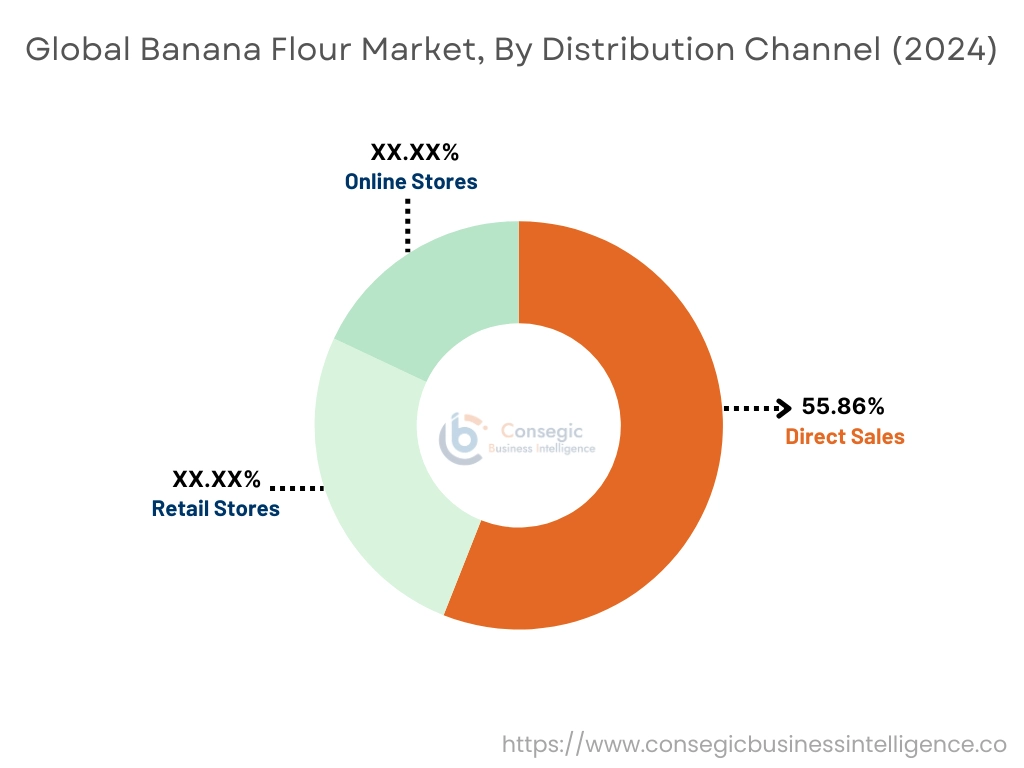
Regional Analysis:
The regional segment includes North America, Europe, Asia Pacific, the Middle East and Africa, and Latin America.
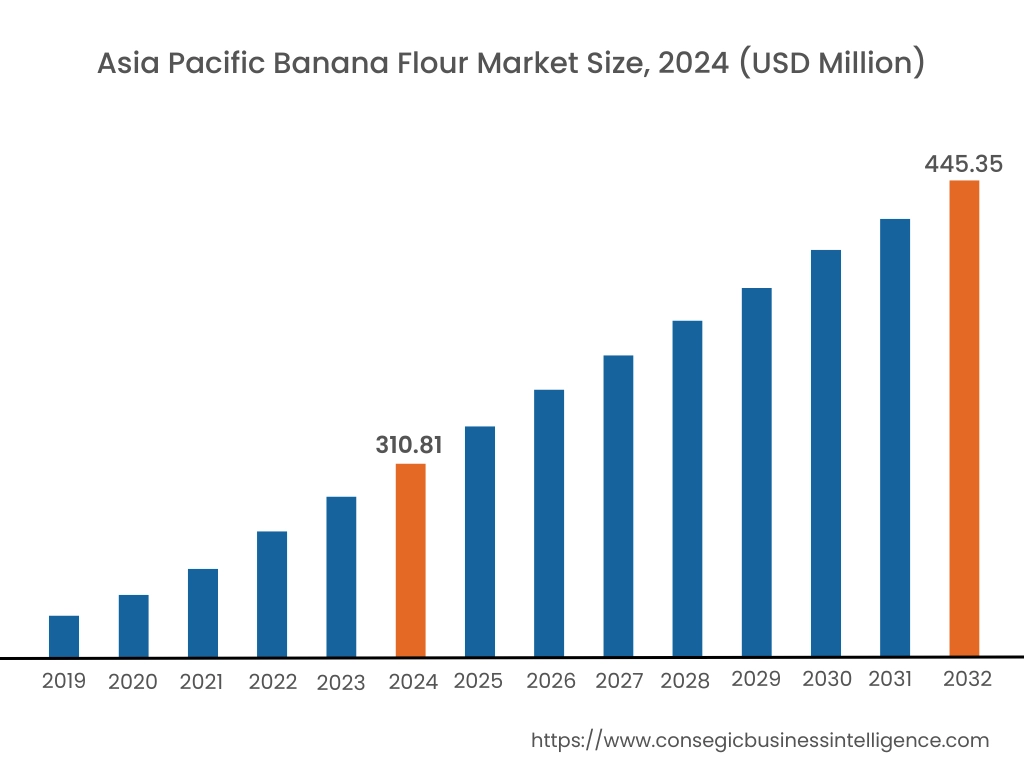
In 2024, Asia Pacific accounted for the highest market share at 39.85% and was valued at USD 310.81 Million and is expected to reach USD 445.35 Million in 2032. In Asia Pacific, China accounted for the market share of 35.12% during the base year of 2024.
The Asia Pacific region is considered as one of the major banana producers, particularly in countries like India, China, the Philippines, and Indonesia. This ensures a readily available and cost-effective supply of raw material for banana flour production. This cost advantage along with the nutritional benefits banana flour provides feed for livestock. This feed includes high resistant starch content, valuable fiber, and essential minerals. This makes it an attractive alternative to traditional feed ingredients.
- For instance, in 2022, according to Feed and Additive Magazine, Asia Pacific contributes to roughly 36.8% in the compound feed production across the globe
Thus, based on the banana flour market analysis, the inclusion of flour made from banana into feed formulations for a range of livestock, from poultry and swine to ruminants and even aquaculture is contributing to the market development in the region.
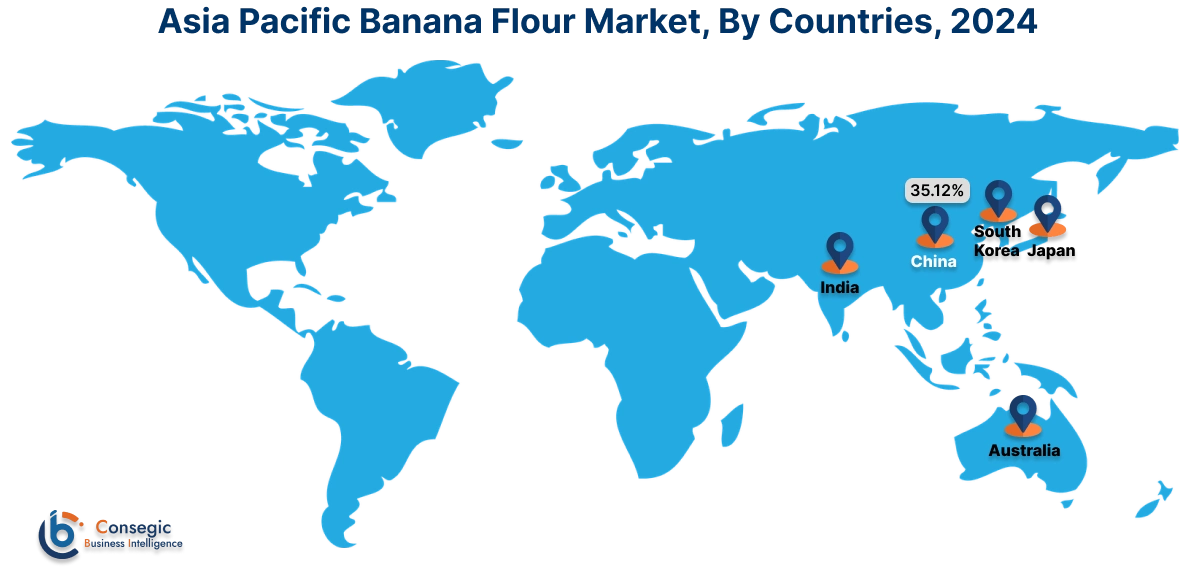
In North America, the banana flour industry is experiencing the fastest growth with a CAGR of 6.5% over the forecast period. Consumers are increasingly aware of the environmental and social implications of their food purchases. They are looking for products that cater to their requirements. This translates to a preference for banana flour. Furthermore, eco-friendly farming, processing, and packaging practices employed by banana flour producers are contributing to the development of the market. These factors allow banana flour brands to differentiate themselves. As consumer awareness of sustainability and ethical issues continues to grow, the banana flour market demand is expected to increase in the region.
The European banana flour market share is driven by the increase in awareness of celiac disease and gluten sensitivity are contributing to the need for gluten-free alternatives like banana flour. The wide availability of such products in retail outlets further facilitates consumer access. Banana flour's usage in several culinary applications makes it an attractive ingredient for both home and commercial use. A few of these applications are baked products, smoothies, and others. These combined factors are driving the European banana flour market expansion.
The growing popularity of plant-based diets in Latin America presents a potential opportunity for the banana flour market. The incorporation of banana flour in the growing plant-based trend creates potential due to its nutritional benefits and culinary versatility. The focus on locally sourced bananas for flour production further drives the availability of the product in the region. Therefore, above-mentioned factors offer potential for development in the Latin American banana flour market.
The use of banana flour in infant food within the Middle East and Africa (MEA) regions presents a potential. While bananas are a dietary staple in many African cultures, and some traditional infant feeding practices incorporate bananas, the widespread adoption of flour from banana in commercial infant food formulations is expected to create a potential for the region. Flour derived from banana offers nutritional advantages for infants, including resistant starch, fiber, and essential minerals. In addition to this, the growing awareness of these nutritional benefits among parents and healthcare providers is also a positive factor. Thus, due to the above-mentioned factors the Middle East and African region is expected to create potential for manufacturers to invest.
Top Key Players and Market Share Insights:
The Global Banana Flour Market is highly competitive with major players providing products to the national and international markets. Key players are adopting several strategies in research and development (R&D) and product innovation to hold a strong position in the global Banana Flour market. Key players in the Banana Flour industry include-
- Pereg Gourmet Spices (U.S.)
- Food Banatone (India)
- Hearthy Foods (U.S.)
- Kokos Natural (India)
- Organic Traditions (U.S.)
- Seawind Foods (U.S.)
- Miski Organics (Canada)
- KADAC Pty Ltd (Australia)
- Natural Evolution (U.S.)
- AIDP (U.S.)
Banana Flour Market Report Insights :
| Report Attributes | Report Details |
| Study Timeline | 2019-2032 |
| Market Size in 2032 | USD 1,177.43 Million |
| CAGR (2025-2032) | 5.3% |
| By Processing Type |
|
| By End Use Industry |
|
| By Distribution Channel |
|
| By Region |
|
| Key Players |
|
| North America | U.S. Canada Mexico |
| Europe | U.K. Germany France Spain Italy Russia Benelux Rest of Europe |
| APAC | China South Korea Japan India Australia ASEAN Rest of Asia-Pacific |
| Middle East and Africa | GCC Turkey South Africa Rest of MEA |
| LATAM | Brazil Argentina Chile Rest of LATAM |
| Report Coverage |
|
Key Questions Answered in the Report
How big is the Banana Flour market? +
In 2024, the Banana Flour market is USD 780.09 Million.
Which is the fastest-growing region in the Banana Flour market? +
North America is the fastest-growing region in the Banana Flour market.
What specific segmentation details are covered in the Banana Flour market? +
By Processing Type, End Use Industry and Distribution Channel segmentation details are covered in the Banana Flour market.
Who are the major players in the Banana Flour market? +
Pereg Gourmet Spices (U.S.), Dr. Food Banatone (India), Seawind Foods (U.S.) are some of the major players in the market.
